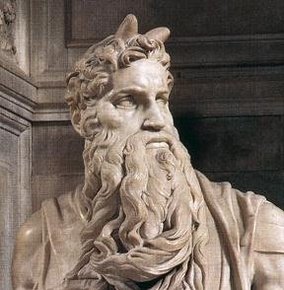
The bit of the tapestry that stood out for me was a depiction of Moses striking the rock at Ka’desh. What’s significant about it is that Moses has horns- and as a Jewish participant said – we know who else has horns. So what does this say about Moses and derivatively about Jews? It’s not unusual to have Moses depicted with horns in Christian art. Perhaps the most famous is Michelangelo’s statue of Moses in The Church of St Peter in Chains in Rome. Did Michelangelo really think Moses had horns? How on earth did this come about?
It’s thought to have originated with Jerome who translated the Hebrew bible into Latin. Exodus 34:29-30 says when Moses came down from Mt Sinai, having seen God face to face and having received the Ten Commandments ‘The skin of his face shone because he had been talking with God. When Aaron and all the Israelites saw Moses, the skin of his face was shining, and they were afraid to come near him’. It’s the word for shining that’s caused the problem. It seems the word in the Hebrew text is qaran or keren and while it can refer to a ray of light it can also refer to a horn. in Jerome’s latin translation he used the word ‘cornuta’ which certainly means a horn – of both the musical and animal kind. According to a commentary Jerome wrote to accompany his translation, he chose ‘horned’ as a metaphor for strength and authority which was not unusual as horns in the ancient world were often seen as symbols of power. However they did come to be associated with Satan and to the shame of Christianity contributed to the demonization of Jews for most of Christian history. In a visit to Poland a number of years ago there was often a horned figure on the periphery of nativity and crucifixion scenes.
So whether the translation of ‘keren’ was a mistake, a choice to show Moses’ authority, it had consequences which influenced people’s understanding of Jews for many centuries. Medieval Christendom abounded with stories and rumours about Jews, all of which we know were untrue. Jews were often in danger for their lives, particularly at this time of year when the stories of the Passion of Jesus led many to see Jews as God-killers. Often Jews would be advised to stay off the streets over the Easter weekend for their own safety.
It’s because of this memory that the second interfaith event was so meaningful. This afternoon, Good Friday, Interfaith Glasgow had invited interested people to attend the Catholic commemoration of the Passion and Death of Jesus. Part of the service is a reading of the Passion from the Gospel of St John. In this account there‘s a lot of talk about the Jews and the High Priests who were conspirators in sentencing Jesus to death. In the past when the scriptures were taken at face value this was taken as further evidence of the Jews as Christ – killers. Things have changed so much so that here I was this afternoon sitting with Jewish friends listening to this reading in a Catholic church with the opportunity to talk about it and ask questions afterwards. It was good to explain how scriptures are religious writings and not to be taken literally – that they reflect a theological position and in John’s case represent growing tensions between the synagogue and the Church. The Church acknowledges that Jesus was put to death by Roman authority and even though some Jewish leaders may have conspired in his death, it’s wrong to blame all Jews for this.
If ever there was a sign that things had changed this was it. Afterwards our Jewish friends were going off to celebrate the first day of Pesach, the foundational feast of their faith and one which gives meaning and interpretation to the life of Jesus. Thank God we Catholics now appreciate and acknowledge our family relationship with Judaism. We rejoice in our friendships. And at this Easter period remember our Jewish brothers and sisters in the faith as we celebrate our own Passover with deeper meaning.


 RSS Feed
RSS Feed
